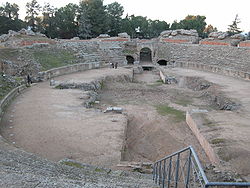Amphitheatre of Mérida: Difference between revisions
m Adding DEFAULTSORT to page with special characters (WP:CHECKWIKI error 37) + genfixes using AWB (7089) |
expand |
||
| Line 1: | Line 1: | ||
{{Infobox World Heritage Site |
|||
| ⚫ | |||
| WHS = [[Archaeological Ensemble of Mérida]] |
|||
The '''Mérida amphitheatre''' is an ancient [[Roman architecture|Roman]] [[amphitheatre]] in [[Mérida, Spain]]. |
|||
| ⚫ | |||
| State Party = {{ESP}} |
|||
| Type = Cultural |
|||
| Criteria = iii, iv |
|||
| ID = 664 |
|||
| Region = [[List of World Heritage Sites in Europe|Europe and North America]] |
|||
| Year = 1993 |
|||
| Session = 17th |
|||
| Link = http://whc.unesco.org/en/list/664 |
|||
}} |
|||
The '''Amphitheatre of Merida''', was built in the roman colony of Emerita Augusta, which was founded in 25 B.C. by [[Augustus|Octavius Augustus]], [[emeritus]] soldiers discharged from the Roman army, two veteran legions of the [[Cantabrian Wars]]: [[Legio V Alaudae]] and [[Legio X Gemina]]. The city was the capital of the [[Roman province]] of [[Lusitania]]. The term emeritus meant in latin "retired" and referred to retired soldiers with honor. |
|||
The amphitheatre was inaugurated in 8 BC: it was to be used for [[gladiator]]s and ferocious animals games. Of elliptical shapes, it measures 126 x 102 m externally, while the inner arena axes measure 64 x 21 m. The steps could house up to 16,000 spectators. The lowest row of steps was reserved to the upper class, while the other 10 were for common people. |
|||
The amphitheater is part of The [[Archaeological Ensemble of Mérida]], which is one of the largest and most extensive archaeological sites in Spain. It was declared a [[World Heritage Site]] by [[UNESCO]] in 1993. |
|||
The arena was provided with a ''fossa bestiaria'' ("animals' tunnel") in the middle, used to house the animals against which the gladiators fought. |
|||
==History== |
|||
Annexed to the amphitheatre are two ancient Roman houses (Spanish: ''Casa de la Torre del Agua'' and ''Casa del Anfiteatro'') |
|||
Construction was popular with more depth than the theater itself, and was inaugurated in the year 8 B.C. This building was intended for [[gladiator]]ial combats. between beasts or men and beasts, so-called venationes. |
|||
==Architectural features== |
|||
[[File:Circor romano de mérida grada.jpg|thumb|200px|left|Stands of the Roman amphitheater of Mérida.]] |
|||
Had an elliptical shape, and had a major axis of 126 m. and one less than 102 m, with these measures in the arena of 64 m. by 41 m. respectively. |
|||
The sand had a ''''''fossa bestiaria'''''' in the center, which was covered with wood and sand. This fossa is used to house animals that later would face the gladiators. |
|||
Its design consists of: a grandstand with ima, media and '''''summa cavea''''', and a central arena. The stands had a carrying capacity of approximately 15,000 spectators and available -'''''Scalae'''''- stairs and hallways that connected the different parts -'''''cune. |
|||
The '''''ima cavea''''' had of a row reserved for the ruling class and 10 more for the public commoner. Also built two stands located at both sides of the minor axis, one above the main entrance hall and another in front. Under them were the inscriptions with which they could date the amphitheater. |
|||
The amphitheater is located in these conditions because this is where they faced the Romans against the Carthaginians in the [[Punic wars]]. |
|||
==See Also== |
|||
* [[Archaeological Ensemble of Mérida]] |
|||
== Enlaces externos == |
|||
* [http://www.merida.es/ Official website of the City council of Merida] |
|||
* [http://www.consorciomerida.org/ Official website of the entity that manages the amphitheater and the archaeological ensemble] |
|||
{{coord|38|54|58.3|N|6|20|15.8|E|display=title}} |
{{coord|38|54|58.3|N|6|20|15.8|E|display=title}} |
||
Revision as of 19:37, 7 October 2010
| UNESCO World Heritage Site | |
|---|---|
 | |
| Criteria | Cultural: iii, iv |
| Reference | 664 |
| Inscription | 1993 (17th Session) |
The Amphitheatre of Merida, was built in the roman colony of Emerita Augusta, which was founded in 25 B.C. by Octavius Augustus, emeritus soldiers discharged from the Roman army, two veteran legions of the Cantabrian Wars: Legio V Alaudae and Legio X Gemina. The city was the capital of the Roman province of Lusitania. The term emeritus meant in latin "retired" and referred to retired soldiers with honor.
The amphitheater is part of The Archaeological Ensemble of Mérida, which is one of the largest and most extensive archaeological sites in Spain. It was declared a World Heritage Site by UNESCO in 1993.
History
Construction was popular with more depth than the theater itself, and was inaugurated in the year 8 B.C. This building was intended for gladiatorial combats. between beasts or men and beasts, so-called venationes.
Architectural features

Had an elliptical shape, and had a major axis of 126 m. and one less than 102 m, with these measures in the arena of 64 m. by 41 m. respectively.
The sand had a 'fossa bestiaria' in the center, which was covered with wood and sand. This fossa is used to house animals that later would face the gladiators.
Its design consists of: a grandstand with ima, media and summa cavea, and a central arena. The stands had a carrying capacity of approximately 15,000 spectators and available -Scalae- stairs and hallways that connected the different parts -cune.
The ima cavea had of a row reserved for the ruling class and 10 more for the public commoner. Also built two stands located at both sides of the minor axis, one above the main entrance hall and another in front. Under them were the inscriptions with which they could date the amphitheater.
The amphitheater is located in these conditions because this is where they faced the Romans against the Carthaginians in the Punic wars.